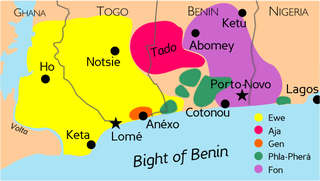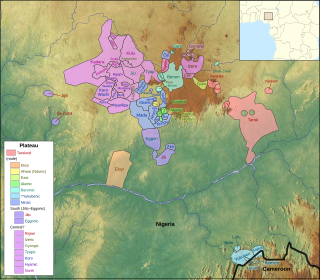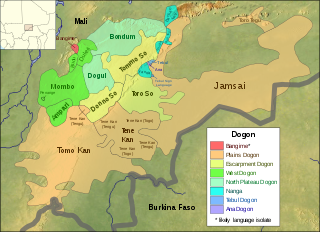Related Research Articles

Fon is spoken in Benin, Nigeria, Togo, Ghana and Gabon by approximately 1.7 million speakers, and is the language of the Fon people. Like the other Gbe languages, Fon is an isolating language with an SVO basic word order.
The phonology of Vietnamese features 19 consonant phonemes, with 5 additional consonant phonemes used in Vietnamese's Southern dialect, and 4 exclusive to the Northern dialect. Vietnamese also has 14 vowel nuclei, and 6 tones that are integral to the interpretation of the language. Older interpretations of Vietnamese tones differentiated between "sharp" and "heavy" entering and departing tones. This article is a technical description of the sound system of the Vietnamese language, including phonetics and phonology. Two main varieties of Vietnamese, Hanoi and Saigon, which are slightly different to each other, are described below.
Goemai is an Afro-Asiatic language spoken in the Great Muri Plains region of Plateau State in central Nigeria, between the Jos Plateau and Benue River. Goemai is also the name of the ethnic group of speakers of the Goemai language. The name 'Ankwe' has been used to refer to the people, especially in older literature and to outsiders. As of 2008, it was estimated there were around 200,000 ethnic Goemai, but it is unknown how many of these are native speakers of the language.
Defaka is an endangered and divergent Nigerian language of uncertain classification. It is spoken in the Opobo–Nkoro LGA of Rivers State, in the Defaka or Afakani ward of Nkọrọ town and Ịwọma Nkọrọ. The low number of Defaka speakers, coupled with the fact that other languages dominate the region where Defaka is spoken, edges the language near extinction on a year-to-year basis. It is generally classified in an Ijoid branch of the Niger–Congo family. However, the Ijoid proposal is problematic. Blench (2012) notes that "Defaka has numerous external cognates and might be an isolate or independent branch of Niger–Congo which has come under Ịjọ influence."

The forty or so Plateau languages are a tentative group of Benue–Congo languages spoken by 15 million people on the Jos Plateau, Southern Kaduna, Nasarawa State and in adjacent areas in central Nigeria.
Tera is a Chadic dialect cluster spoken in north-eastern Nigeria in the north and eastern parts of Gombe State and Borno State. Blench (2006) believes Pidlimdi (Hinna) dialect is a separate language.

Bangime is a language isolate spoken by 3,500 ethnic Dogon in seven villages in southern Mali, who call themselves the bàŋɡá–ndɛ̀. Bangande is the name of the ethnicity of this community and their population grows at a rate of 2.5% per year. The Bangande consider themselves to be Dogon, but other Dogon people insist they are not. Bangime is an endangered language classified as 6a - Vigorous by Ethnologue. Long known to be highly divergent from the (other) Dogon languages, it was first proposed as a possible isolate by Blench (2005). Heath and Hantgan have hypothesized that the cliffs surrounding the Bangande valley provided isolation of the language as well as safety for Bangande people. Even though Bangime is not closely related to Dogon languages, the Bangande still consider their language to be Dogon. Hantgan and List report that Bangime speakers seem unaware that it is not mutually intelligible with any Dogon language.

The Angas, Angas–Sura, or Central West Chadic languages are a branch of West Chadic languages spoken in Plateau State, north-central Nigeria.
Cipu (Cicipu), or Western Acipa, is a Kainji language spoken by about 20,000 people in northwest Nigeria. The people call themselves Acipu, and are called Acipawa in Hausa.
Izi is an Igboid language spoken in Ebonyi state in Nigeria. It forms a dialect cluster with the closely related languages Ikwo, Ezza, and Mgbo.
The Dogon dialects of the western plains below the Bandiagara Escarpment is Mali are mutually intelligible. They are sometimes called the Kan Dogon because they use the word kan for varieties of speech. The dialects are:
Kare is a southern Mbum language of the Central African Republic, spoken by the Kare people in the mountains of the northeasterly Ouham-Pendé prefecture around Bocaranga. It is spoken by around 97,000 people in the country, and another few thousand speakers in Cameroon. The language's presence on the southeastern edge of the Mbum family is thought to reflect early 19th-century migrations from the Adamawa Plateau, fleeing Fulani raids.
Yiwom (Ywom), also known as Gerka or Gerkawa by the Hausa, is a Chadic (Afro-Asiatic) language spoken in Plateau State, Nigeria.
Berom or Birom is the most widely spoken Plateau language in Nigeria. The language is locally numerically important and is consistently spoken by Berom of all ages in rural areas. However, the Berom are shifting to Hausa in cities. The small Cen and Nincut dialects may be separate languages. Approximately 1 million (2010) people speak in this language.
Idun (Idũ), or Dũya, is a poorly attested Plateau language of Nigeria. Its classification is uncertain, but it may be closest to Ashe.
Jibu is a Jukunoid language spoken in the Taraba State of Nigeria by 30,000 people.
Kuteb also known as Ati, Kutev, Mbarike is a Nigerian ethnic language. The Kuteb people mostly live in the southern part of Taraba state in Nigeria, with a thousand-or-so speakers across the border in Cameroon. In Nigeria, it is spoken mostly in Takum and Ussa LGAs, and Yangtu SDA Taraba State.
Polci is an Afro-Asiatic language of Bauchi State, Nigeria. It is part of the Barawa cluster, which is in turn part of the West Chadic language family.
Mvanip (Mvano), or Magu, is a minor Mambiloid language of Nigeria. Despite the small number of speakers, language use is vigorous. Ethnologue classifies Mvanip as threatened.
Yebu is one of the Savanna languages of Kaltungo LGA in Gombe State, northeastern Nigeria.
References
- ↑ NE & NW Izere at Ethnologue (18th ed., 2015) (subscription required)
Cèn (Chen) at Ethnologue (18th ed., 2015) (subscription required)
Ganàng (Gashish) at Ethnologue (18th ed., 2015) (subscription required) - ↑ Blench, Roger (2019). An Atlas of Nigerian Languages (4th ed.). Cambridge: Kay Williamson Educational Foundation.
- ↑ Blench, Roger; Kaze, Bitrus. Dictionary of the Izere language.
- Blench (2008) Prospecting proto-Plateau. Manuscript.